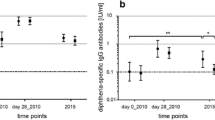Abstract
Immunization is a safe, effective and simple way of preventing life-threatening tetanus infection in children and adults, and is therefore recommended for all age groups in all European countries. In older persons, despite waning immunity with increasing age, the majority of vaccinees attain protective tetanus immunity under a proper vaccination schedule. Based on the scientific evidence, decennial boosters are recommended for elderly persons who have received primary tetanus vaccination in the past. Until recently, pertussis vaccination was understood as an early childhood intervention. Due to decreasing immunity, re-vaccination of youngsters and adults is recommended and is also considered for seniors 60 years and over. Routine immunization of seniors against pertussis every ten years yields a high level of protection of older individuals, and at the same time contributes to epidemiological control of pertussis in the population.
Similar content being viewed by others
References
Dundar V, Ymuk Z, Ozturk-Dundar D, Erdogan S, Gacar GJ. Prevalence of tetanus immunity in the Kocaeli region, Turkey. Jpn J Infect Dis 2005; 58: 279–82.
Pascual FB, McGinley EL, Zanardi LR, Cortese MM, Murphy TV. Tetanus surveillance: United States, 1998–2000. Morb Mortal Wkly Rep Surveill Summ 2003; 52: 1–8.
de Melker HE, van den Hof S, Berbers GA, Nagelkerke NJD, Rümke HC, Conyn-van Spaendonck MA. A population-based study on tetanus antitoxin levels in the Netherlands. Vaccine 2000; 18: 100–8.
de Melker HE, van den Hof S, Berbers GA, Conyn-van Spaendonck MA. Evaluation of the national immunization program in the Netherlands: immunity to diphtheria, tetanus, poliomyelitis, measles, mumps, rubella and Haemophilus influenzae type b. Vaccine 2003; 21: 716–20.
Kretsinger K, Broder KR, Cortese MM et al; Centers for Disease Control and Prevention; Advisory Committee on Immunization Practices; Healthcare Infection Control Practices Advisory Committee. Preventing tetanus, diphtheria, and pertussis among adults: use of tetanus toxoid, reduced diphtheria toxoid and acelter lular pertussis vaccine, recommendations of the Advisory Committee on Immunization Practices (ACIP) and recommendation of ACIP, supported by the Healthcare Infection Control Practices Advisory Committee (HICPAC), for use of Tdap among health-care personnel. MMWR Recomm Rep 2006; 55: 1–37.
Maclennan R, Schofield FD, Pittman M, Hardegree MC, Barile MF. Immunization against neonatal tetanus in New Guinea: antitoxin response of pregnant women to adjuvant and plain toxoids. Bull World Health Organ 1965; 32: 683–97.
Björkholm B, Hagberg L, Sundbeck G, Granström M. Booster effect of low doses of tetanus toxoid in elderly vaccinees. Eur J Clin Microbiol Infect Dis 2000; 19: 195–9.
Gergen PJ, McQuillan GM, Kiely M, Ezzati-Rice TM, Sutter RW, Virella G. A population-based serologic survey of immunity to tetanus in the United States. N Engl J Med 1995; 332: 761–6.
McQuillan GM, Kruszon-Moran D, Deforest A, Chu SY, Wharton M. Serologic immunity to diphtheria and tetanus in the United States. Ann Intern Med 2002; 136: 660–6.
Dominguez A, Plans P, Costa J et al. The seroepidemiology of tetanus in Catalonia, Spain. Med Microbiol Immunol 2007; 196: 115–9.
Hainz U, Jenewein B, Asch E, Pfeiffer KP, Berger P, Grubeck-Loebenstein B. Insufficient protection for healthy elderly adults by tetanus and TBE vaccines. Vaccine 2005; 23: 3232–5.
Kaml M, Weiskirchner I, Keller M et al. Booster vaccination in the elderly: their success depends on the vaccine type applied earlier in life as well as on pre-vaccination antibody titers. Vaccine 2006; 24: 6808–11.
Maple PAC, Jones CS, Wall EC et al. Immunity to diphtheria and tetanus in England and Wales. Vaccine 2000; 19: 167–73.
Walory J, Grzesiowski P, Hryniewicz W. Immunity against diphtheria and tetanus in the adult Polish population. Pol Merkur Lekarski 2000; 9: 687–92.
Fordymacka A. Immunity against diphtheria and tetanus in various age groups after 40 years since implementation of the mass vaccination program. Przegl Epidemiol 2000; 54: 333–41.
CDC. General recommendations on immunization: recommendations of the Advisory Committee on Immunization Practices (ACIP). MMWR 2006; 55 (No. RR-15).
Pichichero ME, Rennels MB, Edwards KM et al. Combined tetanus, diphtheria, and 5-component pertussis vaccine for use in adolescents and adults. JAMA 2005; 293: 3003–11.
Simonsen O, Badsberg JH, Kjeldsen K et al. The fall-off in serum concentration of tetanus antitoxin after primary and booster vaccination. Acta Pathol Microbiol Scand 1985; 94: 77–82.
Janout V, Matouskova I, Machova L, Cizek L, Janoutova G, Hoskova J. Protection against tetanus in the aged people in the Czech Republic. A cross-sectional study. Arch Gerontol Geriatr 2005; 40: 123–8.
Wassilak SGF, Roper MH, Kretsinger K, Orenstein WA. Tetanus toxoid. In Plotkin S, Orenstein W, Offit P, eds. Vaccines. 5th ed. Saunders Elsevier, 2008.
Relyveld EH, Bizzini B, Gupta RK. Rational approaches to reduce adverse reactions in man to vaccines containing tetanus and diphtheria toxoids. Vaccine 1998; 16: 1016–23.
Lloyd JC, Haber P, Mootrey GT, Braun MM, Rhodes PH, Chen RT. Adverse event reporting rates following tetanus-diphtheria and tetanus toxoid vaccinations: data from the Vaccine Adverse Event Reporting System (VAERS), 1991–1997. Vaccine 2003; 21: 3746–50.
CDC. Percentage of persons aged ≥18 years who reported receiving influenza or pneumococcal vaccine or tetanus toxoid, by age and selected characteristics — National Health Interview Survey, United States, 1999. Available at http://www.cdc.gov/nip/coverage/NHIS/tables/general-99.pdf. Accessed February 28, 2009.
CDC. Record of the Meeting of the Advisory Committee on Immunization Practices, October 26–27, 2005. Available at http://www.cdc.gov/nip/ACIP/minutes/acip-min-oct05.pdf. Accessed February 28, 2009.
Scott J, Hickey J. Immunizing adults against tetanus and diphtheria. Can Fam Physician 2003; 49: 587–8.
Bartošovič I, Krajčík Š, Hegyi L. Vaccination of social care facility residents agains influenza and tetanus (in Slovak). Geriatria 2001; 7: 164–8.
Edwards KM Decker MD. Pertussis vaccines. In Plotkin S, Orenstein W, Offit P, eds. Vaccines. 5th ed. Saunders Elsevier, 2008.
Kerr J, Matthews R. Bordetella pertussis infection: Pathogenesis, diagnosis, management, and the role of protective immunity. Eur J Clin Microbiol Infect Dis 2000; 19: 77–88.
Rendi-Wagner P, Paulke-Korinek M, Stanek G, Khanakah G, Kollaritsch H. Impact of a pertussis booster vaccination program in adolescents and adults on the epidemiology of pertussis in Austria. Pediatr Infect Dis J 2007; 26: 806–10.
de Melker HE, Schellekens JF, Neppelenbroek SE, Mool FR, Rumke HS, Conyn-van Soaendonck MA. Reemergence of pertussis in the highly vaccinated population of the Netherlands, observation on surveillance data. Emerg Infect Dis 2000; 6: 348–57.
Quinn HE, McIntyre PB. Pertussis epidemiology in Australia over the decade 1995–2005 — trends by region and age group. Commun Dis Intell 2007; 31: 205–15.
Halperin SA. The control of pertussis 2007 and beyond. N Engl J Med 2007; 356: 110–3.
Wirsing von Konig CH, Halperin S, Riffelmann M, Guiso N. Pertussis of adults and infants. Lancet Infect Dis 2002; 2: 744–50.
Robbins JB, Schneerson R, Trollfors B et al. The diphteria and pertussis components of diphteria-tetanus toxoids-pertussis vaccine should be genetically inactivated mutant toxins. J Infect Dis 2005; 191: 81–8.
CDC: Pertussis — United States, 2001–2003. Morb Mortal Wkly Rep 2005; 54: 1283–6.
Conference report: International Bordetella pertussis assay, standardization and harmonization meeting report. Center for Disease Control and Prevention, Atlanta, Georgia, United States, 19–20 July 2007. Vaccine 2009; 27: 803–14.
Hu JJ, Lu CY, Chang LY et al. Survey of pertussis in patients with prolonged cough. J Microbiol Immunol Infect 2006; 39: 54–8.
CDC. Preventing tetanus, diphtheria, and pertussis among adults: use of tetanus toxoid, reduced diphtheria toxoid and acellular pertussis vaccine: recommendations of Advisory Committee on Immunization Practices (ACIP) and recommendation of ACIP, supported by healthcare personnel. Morb Mortal Wkly Rep 2006; 55: 1–3.
McIntyre PB, Burgess MA, Egan A, Schuerman L, Hoet B. Booster vaccination of adults with reduced-antigen-content diphteria, tetanus and pertussis vaccine: immunogenicity 5 years post vaccination. Vaccine 2009; 27: 1062–6.
Cortese MM, Baughman AL, Brown K, Srivastava P. A “new age” in pertussis prevention: new opportunities through adult vaccination. Am J Prev Med 2007; 32: 177–85.
Keitel W. Cellular and acellular pertussis vaccines in adults. Clin Infect Dis 1999; 28 (Suppl 2): S118–23.
Rothstein E, Anderson E, Decker M, Poland G, Reisinger K, Langerberg A. An observer-blinded, randomised, placebo-controlled study of the safety and immunogenecity of an acellular pertussis vaccine (aP) in healthy adults (abstract G-29) In Abstracts of the 38th Interscience Conference of Antimicrobial Agents and Chemotherapy (ICAAC). ASM, Washington, 1998.
Shefer A, Dales L, Nelson M, Werner B, Baron R, Jackson R. Use and safety of acellular pertussis vaccine among adult hospital staff during an outbreak of pertussis. J Infect Dis 1995; 171: 1053–6.
Edelman K, He Q, Makinen J et al. Immunity to pertussis after booster immunization during adolescence. Clin Infect Dis 2007; 44: 1271–7.
Le T, Cherry JD, Chang SJ et al. Immune response and antibody decay after immunization of adolescents and adults with acellular pertussis vaccine: the APERT Study. J Infect Dis 2004; 190: 535–44.
Coudeville L, van Rie A, Andre P. Adult pertussis vaccination strategies and their impact on pertussis in the United States: evaluation of routine and targeted (cocoon) strategies. Epidemiol Infect 2008; 136: 604–20.
Author information
Authors and Affiliations
Corresponding author
Rights and permissions
About this article
Cite this article
Topinkovà, E., Marešovà, V. Tetanus and Pertussis vaccines: their usefulness in the aging population. Aging Clin Exp Res 21, 229–235 (2009). https://doi.org/10.1007/BF03324910
Received:
Accepted:
Published:
Issue Date:
DOI: https://doi.org/10.1007/BF03324910




